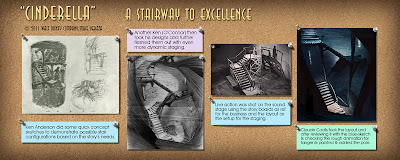 |
| Original Title Card for Cinderella |
This is roughly how a day in Ken's class would unfold. I dragged myself out of bed at 6:30, ate an orange and then after meeting Ken at his car, we walked to class where I would unlock the door as no one was there yet. As TA I had keys to all the Character Animation rooms which made it easier for fellow students to get access after hours. He used a foldable rolling cart on top of which he placed items like a converted fishing tackle box. This box held a hodge-podge of art supplies neatly arranged within its drawers. Endless goodies from pastels to paint and compasses to canvas rolls could be brought forth from that small box much like Mary Poppins did with her magical carpet bag. I would help Ken set up a still life for our first class exercise in the morning. He did the artistic placement, me the heavy lifting. These could be anything from a stuffed eagle on a branch waiting to pounce upon a equally stuffed rabbit to an arrangement of musical instruments made of shiny brass and dark wood to a collection of old antique brass and copper lamps.
 |
| Stepsisters by Mary Blair |
In this way Ken would help us decipher how to properly translate various surfaces in our illustrations such as the metallic reflection of a trumpet, a subdued highlight on fine oiled wood, the sheen of silk drapery to the soft fringe of a feathered wing. After lunch we would then move on to unique perspective problems that he would setup for us using handouts and the over head projector. After the head numbing problems solving missing perspectives of a cross on a hill, Ken would take pity on the class. He did this by bringing in examples from the Walt Disney Studios showing the various stages used in creating the family of famous Disney classics beginning with "
Cinderella," a film he knew very well.
 |
| Bedroom Concept, Live Action, Layout & Painted BG |
He started off by bringing in a written treatment with concept art featuring
Mary Blair,
Ken Anderson,
Bill Pete and
John Hench followed the next week by storyboards and workbooks by talents like Bill Pete and
Ken Anderson. We would then see the rough and final layouts from he,
Don Griffith and
Tom Codrick and others, then eventually the beautiful background paintings from
Claude Coats and
Art Riley including the discards such as the infamous Palace interior section that was completely discarded and had to be redone. We also studied the live action film reference from stills to the film comparing it to the animation derived from the rotoscoping of its poses until finally we watched the entire film in the theater with Ken as our MC as he made comments (
some were hilarious) as to production problems and anecdotes about the film's production.
This procedure was followed on additional Disney classic films as we were exposed to more and more artists, their different styles and techniques, and the steps taken to produce these classics, including mistakes and failed attempts as well as the successful conclusion.To the left is a breakdown of an example of how the various stages of just one area, in this case the tower stairway, was developed and used in the film, "Cinderella". I wish I had the space to transfer all of my notes and photos of those sessions from my class book to these blog pages, it was a real treat for all of us.
 |
| Ken and Mike CalArts 1976 |
After being exposed to the Disney classics in such illuminating detail, we could hardly wait to get back to our desks and begin sketching. Ken also introduced us to the process of adding powders to our renderings such as Graphite or charcoal. After applying that technique though, one has to "fix" it in place by using a spray so we all started using spray fixative to set the renderings. I am surprised we weren't asphyxiated if you can imagine a dozen kids spraying fixative in the hallway at the same time, phewwww. After the spray fests it was a relief just to run outside and breath in the smog! I actually switched my colon from Old Spice to Blair Fixative while attending Ken's classes.
Although I loved Ken's classes in particular, after the first semester, I ran out of money which was very embarrassing and was going to leave the school. Remarks from teachers like
Ken O'Connor helped influence the Disney Studio and the Disney family who offered me a full scholarship to stay on for which I am eternally grateful to all of them.






